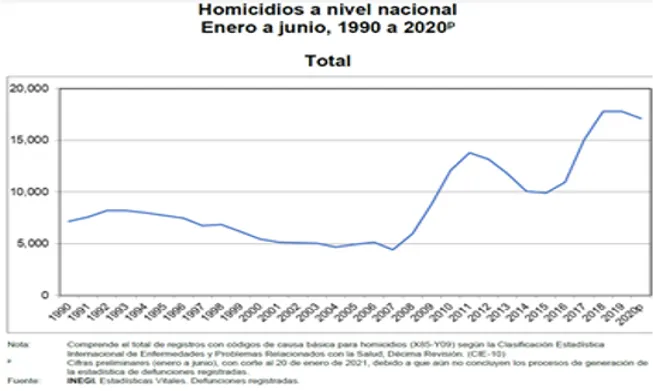According to data expressed by INEGI (Instituto Nacional de Estadística y Geografía) and SESNSP (Secretariado Ejecutivo del Sistema Nacional de Seguridad Pública), during 2020 violence in Mexico continued at current rates and in some cases even exceeded previous years. These data are aggravated if we consider that 2020 was a year characterized throughout the world by restrictions on social interaction in response to the COVID-19 pandemic.

Source: INEGI. Comunicado de prensa número 27/21. 26/01/2021.
In words of Charles Tilly (2003), we can speak of collective violence when there is damage to the physical integrity of the person or property damage. The high rates of violence in the country have been going on for more than a decade and although it sometimes has fluctuations that apparently reduce some indicator of violence, when looking at the data disaggregated by state (SESNSP) we see that each year it increases in some places. From these data we must also consider around 95% of unreported crimes.
Various studies over the last few decades have made it clear that strategies such as the direct fight against drug trafficking and other forms of criminal associations were ineffective and even increased crime rates instead of reducing them. How can we break the cycle from a sociological point of view?
About a year before the pandemic, a new strategy began to be implemented whose objective was, on the one hand, to combat all manifestations of corruption in the government and, on the other, to repair the social fabric by improving socioeconomic conditions and strengthening solidarity in the family and local communities.
In this way, it was supposed to remove incentives from vulnerable sectors to join drug trafficking or to carry out other criminal acts such as robberies and kidnappings.
The implementation is in the early stages and the effects will be seen in the long term, possibly in two or three generations if the strategy continues to receive a constant flow of material and symbolic resources in the following years. The effectiveness of this will also have to be evaluated in the face of the economic crisis that we are going through because of COVID-19.
Changing the situation of violence requires modifying the system of values that reproduce practices of violence. To eradicate those levels of violence in both the public and private spheres we must transcend all forms of polarization that destroy solidarity and constrict the possibilities of change.
References:
Charles Tilly (2003). The politics of collective violence, Cambridge University Press, USA.
Secretariado Ejecutivo del Sistema Nacional de Seguridad Pública. Cifras de delitos y víctimas por cada 100 mil habitantes 2015-2021, disponible: https://drive.google.com/file/d/16U2jUPz25vEPsTRH_mNeIye1RCZybNja/view.





